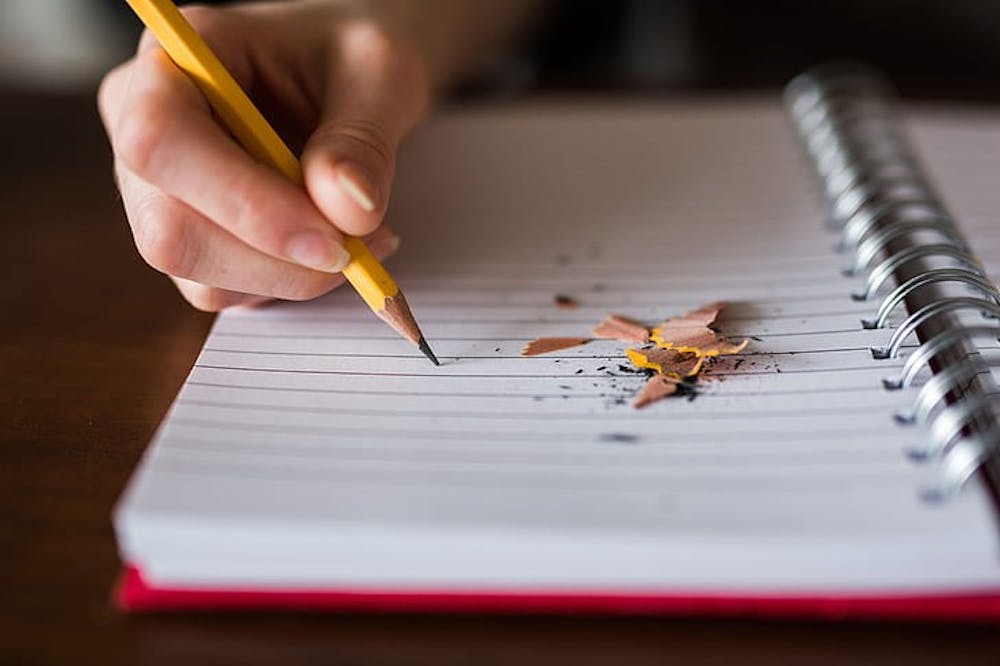Two weeks ago, I wrote a column justifying my obstinate refusal to switch from paper notes to digital notes; in a similar vein, I wish to write this column to justify yet another obsolete school-related habit of mine: standard pencils. More and more often, I see my fellow students resorting to mechanical pencils. And less and less frequently can I find public-use pencil sharpeners on campus. My family members — the same ones who unsuccessfully tried to persuade me of the merits of electronic note-taking — have all given up standard pencils in favor of pens, mechanical pencils, or nothing at all. So, naturally, I also entertained some reasons why I might consider switching to mechanical pencils.
The most obvious advantage of mechanical pencils is that they do not require pencil sharpeners. A mechanical pencil does not require any maintenance until its lead runs out. Meanwhile, in order to maintain my pencil habits, I must keep not one but two pencil sharpeners. One, a small manual one, fits into my backpack for emergency situations, such as breaking the point off a pencil during a class or using a pencil up in the course of an examination. It leaks pencil dust into my bag and lacks the capability to produce pencils that are truly sharp, but proves effective in desperation. The other, an electronic model, sits on my desk in my dorm room, and I use this occasionally to re-sharpen very dull pencils. It makes a sound reminiscent of loud dental equipment and occasionally sprays pencil shavings back onto the desk, yet, sharpens pencils just to my liking. Using mechanical pencils would eliminate the necessity to keep both of these instruments with their many flaws.
Furthermore, mechanical pencils are capable of writing much finer than standard pencils. The finest one can write with a standard pencil depends on how sharp it is; the more one writes with a standard pencil, the less fine it can be. Mechanical pencils avoid this problem by maintaining the same thickness of lead. Mechanical pencils create notes that look, well, mechanical. They create consistency in note-taking that standard pencils simply lack, which is certainly attractive.
The environment also plays a role in the pencil industry as well. Mechanical pencils consist of reusable bases, with lead to be replaced. If I were to buy a collection of mechanical pencils, I could theoretically use their bases forever, only ever needing to buy canisters of lead supplements. Standard pencils, on the other hand, grow shorter after use. In fact, not enjoying the feel of pencils shorter than about two inches, I often discard short pencils, wasting a certain amount of wood, in addition to all of the wood that becomes wasted each time I sharpen my pencils. In short, mechanical pencils provide not only an environmentally-friendly alternative to standard ones, but also an economic option, causing less waste and requiring less replacement.
Yet, in exactly the same way as I discovered that the alleged shortcomings of paper notes were precisely their strengths, I see again that the alleged shortcomings of standard pencils are what attract me to them.
Both mechanical pencils and standard pencils require a certain degree of maintenance; while the regular sharpening of standard pencils is certainly more frequent than lead replacement in mechanical pencils, replacing lead is significantly less cathartic of an activity than grinding down a pencil. Each time I remove my pocket pencil sharpener from my bag, I feel a certain professional feeling, a confidence, that is absent from a simple lead refill.
The fact that mechanical pencils write so finely allows for beautiful looking notes, but also makes them difficult to use. If I write firmly with a mechanical, it will break. My general clumsiness prohibits me from using any mechanical pencil with a lead below a thickness of 1.3 millimeters without breaking the pencil at least once a word. A 1.3-millimeter lead is so thick that it defeats the purpose of using mechanical pencils to write with a thin, even breadth. While I could train myself to write more gently, it is undeniably easier to simply write with a pencil that requires less care not to break.
Furthermore, the option to write firmly and darkly with a standard pencil increases my confidence. Writing hesitatingly, which I need to do with a mechanical pencil lest it break, does not inspire this same confident feeling in me as writing darkly with a standard pencil.

Additionally, I can choose whether to write darkly or not with a standard pencil, a choice which I sacrifice when using a mechanical pencil. In drawing graphs in my notebook, for example, I can draw thin and thick lines, dark or light, all with the same tip of my pencil. A mechanical pencil simply lacks this multi-functionality.
While I may soon become the only student I know who uses standard pencils, I will certainly not switch to mechanical pencils anytime soon. Although they have increased in popularity considerably, mechanical pencils still retain several shortcomings that keep them out of my school supplies: they break uncontrollably and only write with one thickness. The standard No. 2 pencil, whose ubiquitous yellow patina has decorated classrooms for generations, will continue to occupy a deserved place among my desk supplies as well.
Ollie Thakar is a first-year from Baltimore, M.D. He can be reached at othakar@princeton.edu.









